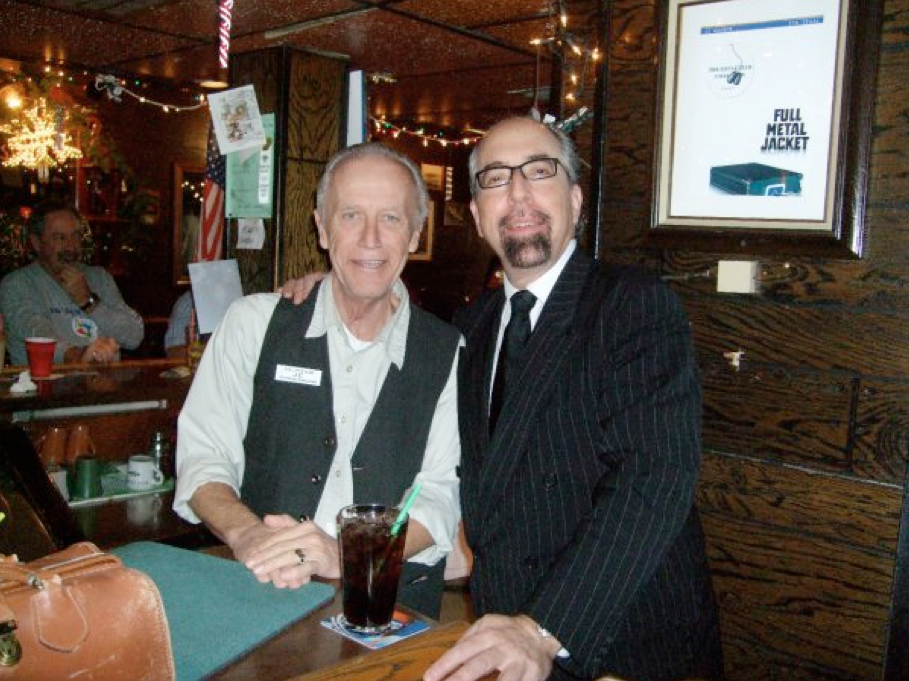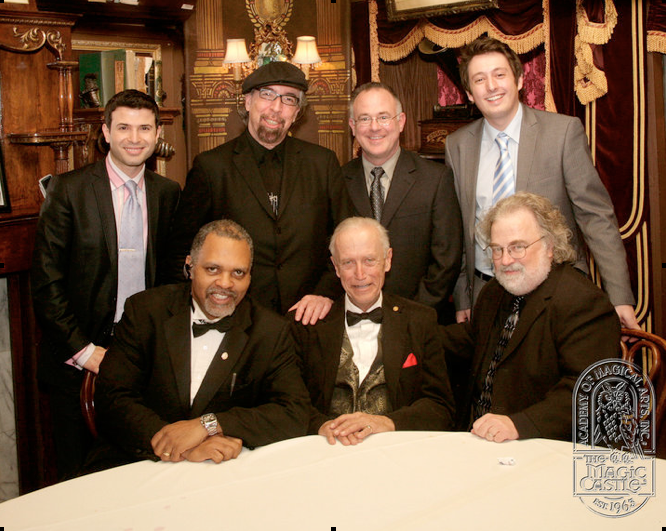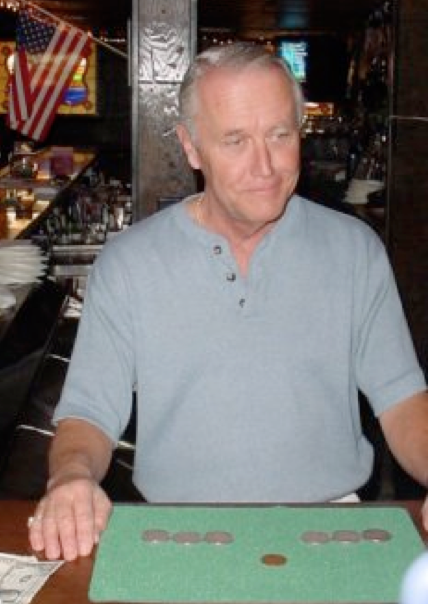Submitted by Jamy Ian Swiss on
J.C. Wagner
In Take Two #25, Part Two about Street Magic, I briefly mention the Chicago school of Magic Bartending, and the role of Bob Sheets in bringing that style into the modern era. Bob performed for a time with the original Chicago Magic Bartender, “Heba Haba Al” Andrucci (who learned his first magic trick from the pioneer of Chicago Magic Bar, Matt Schulien), and in turn Bob would eventually train or influence a line of successors in the Magic Bar tradition, including Steve Spill, Doc Eason, Eric Mead, J.C. Wagner, Scotty York, and myself.
J. C. Wagner and Bob Sheets both grew up in San Diego and were friends and magic buddies from a young age, sharing membership in a local “Junior Magicians Club” created by a working pro named Larry Grummet. The interconnections between J.C. and Bob’s magic lives would eventually play a pivotal role in J.C.’s life. But J.C.’s magical journey was a long and winding one, that proceeded along a path of historic proportions—learning from, sharing with, and eventually guiding and influencing the very best magicians of his time.
J.C. did his first paid public show in his teens, and the summer of his junior year of high school he made his way to Disneyland for a summer job as a magic demonstrator in Merv Taylor’s Merlin’s Magic Shop in the Sleeping Beauty Castle; he then moved to the Main Street Magic Shop working behind the counter alongside another teenaged magic demonstrator, a funny and creative young guy named Steve Martin. And J.C. returned to working in Disneyland after his high school graduation, taking an apartment in the vicinity to facilitate a full-time job at a gift shop in the Disneyland Hotel.
Upon getting drafted in 1965, J.C. did a four-year stint in the Air Force, but continued to study magic in earnest. Moving back to San Diego following his discharge, he began bartending at the Southwestern Yacht Club, where he only did a little magic when the opportunity presented, but that was where he would begin a lifelong pursuit of mixing magic and cocktails.
Reunited in San Diego, J.C. and Bob Sheets would drive up to L.A. to frequent the Magic Castle, when the Castle, and Dai Vernon’s relocation there as the resident guru, transformed Los Angeles into Ground Zero of the most cutting edge close-up magic on the planet. In a marvelous cover story interview in the April 2010 issue of Genii magazine, conducted by J.C. friend and protégé, San Diego cardician Syd Segal (who co-authored J.C.'s booklet, Full Metal Jacket), J.C. mentions the names of some of the magicians he was hanging out with in those golden and legendary days, including Vernon himself, along with Vernon acolytes Bruce Cervon, Larry Jennings, Michael Skinner, Al Goshman, David Roth, Steve Freeman, and more. Those were indeed the days.
But J.C.’s remarkable resumé was only just getting under way. Bob Sheets had spent some time in Chicago working with and learning Magic Bar from Heba Haba Al, and a few months after Bob returned to San Diego, he landed jobs for himself and J.C. at Marco’s Roman Room on Coronado Island. This is when and where, with Sheets’ encouragement, J.C. really became a bar magician—where, as he says in the interview, “I realized my full potential and to be quite honest, let loose.” J.C. was frank about the importance of Bob’s influence. “He really is the reason I am where I am today.”
J.C. worked various other magic gigs, including at a couple of short-lived Los Angeles restaurants called “David Copperfield’s.” But then in 1977 he was offered the opportunity to create a real Magic Bar of his own right in San Diego. Ever the passionate student, J.C. embarked on a vision quest, visiting three legendary Magic Bars: Tom Mullica’s Tom Foolery in Atlanta (Take Two #42); Eddie Fechter’s Forks Hotel in Buffalo (Take Two #33); and to Chicago to see the legendary Heba Haba Al. J.C. would put these lesson and inspirations to use as he returned to San Diego and created, from the ground up, the Magic Lounge.
The Magic Lounge opened to rapid success. But after the first six months, J.C. bowed out of his role as partner, preferring to serve as manager and performer. And once the bar was stabilized with a staff of several local performers, J.C. then picked up and went to Aspen, Colorado, to join up yet again with Bob Sheets, who had brought Magic Bar to a lively ski season joint called the Jolly Jester.
Bob would become a local fixture in Aspen, eventually moving to the Tower Restaurant and Magic Bar, in Snowmass, partly owned by the singer John Denver, and where Bob would eventually bring in Doc Eason (who would in turn invite Eric Mead on board). Bob would eventually depart, along with Steve Spill, for what would become the Brook Farm Inn of Magic in Chevy Chase (where Bob would be a part-owner) in the Maryland suburbs of Washington, D.C. (and eventually to the Inn of Magic in Wheaton, where I would end up the final strand in Sheets’ long braid of Magic Bar DNA).
Meanwhile however, J.C., by way of his friend Larry Jennings, was introduced to the management of the Magic Island club in Newport Beach. J.C. was promptly hired on as Magic Bartender, but before long became a resident close-up performer, and then eventually Entertainment Director, booking the acts. Although J.C. would eventually part ways with Magic Island (one of a string of decisions that would help lead to its eventual demise), he regarded Magic Island as a peak of his long career in magic. This is where he got to perform steadily for an upscale clientelle, countless celebrities, and also expanded his relationships with other magicians across the country, both those he was booking, and others who would simply come by the place to spend time, including names from Lance Burton to Derek Dingle, Ricky Jay and Jerry Camaro.
After Magic Island, J.C. was far from done in the world of magic. He went to Arizona to spend ten months as the Magic Bartender at an upscale tennis club where Mike Finney and other local magicians were doing shows. He had also published several well-received books along the way, and so when the Arizona project ended, J.C. got in his car and did his first nationwide lecture tour, teaching his distinct brand of original magic in no less than 26 cities across the U.S.
But when that was over, J.C. returned to San Diego and decided that, having accomplished or exceeded all of his goals in magic, he was due to settle down and be more of a parent to his two young children. He got himself a day job, worked on foreign cars as a mechanic, and for the next decade laid low in the magic scene while he attended to his family. All the while however he kept up on his own magic in the quiet of his home study.
After a decade's absence, J.C. would publicly return to magic in 2003, performing at the Magic Castle, in the then newly created W.C. Fields Bar (in what is now known as the Inner Circle in the lower level of the Castle, by the library and the Peller Theater). J.C. had achieved respected status in the world of magic, and during this period appeared at select conventions in England and around the U.S. He was honored by the Academy of Magical Arts (Magic Castle) with a Performing Fellowship, and featured on the cover of Genii magazine. I can confidently recount that all of these thoroughly deserved tributes and recognitions, for a lifetime of achievement in his art, had tremendous impact on J.C.—not in an egocentric way, but in an authentic, kind of pure and joyful sort of way, that came from receiving the comfort and assurance that he was genuinely valued as an artist and a member of our community.
I initially discovered J.C.’s work through his books, and then eventually met him in the '80s, sharing as we did our specialized experience in Magic Bar and our shared influences in Bob Sheets and, more distantly, Heba Haba Al. When J.C. gave me a marketed original trick of his known as “Factory Misprints,” I came up with a way to follow the trick with another classic close-up routine that helped the mystery of the overall piece, and J.C. adopted this and added my contribution to the instructions. Eventually, in 2006, I would write and produce a complete booklet about the routine for J.C., which I still publish today.
When I relocated from New York City to San Diego in 2008, I had one sole friend here, and that friend was J.C. Wagner. At the time he had been working a couple of days a week, since 2003, at a small dive bar on Coronado known as the Little Club. He worked the day shift on Saturday afternoons, and I quickly discovered that although there was a traditional organized magic club in San Diego, the more hardcore sleight-of-hand guys and the younger insider crowd gathered at The Little Club every Saturday afternoon to talk and trade magic and, especially, to watch, listen, and learn from their local maestro, J.C. Wagner.

J.C. Wagner and Jamy Ian Swiss at The Little Club, Coronado Island, ca 2009. Photo by Jeff Pearson
I couldn’t make it every week, but I tried to drop in as often as I could, and it was always a pleasure just to hang around with my old friend, watch him perform, swap tales of friends past and present, and occasionally step behind the bar myself to do a set.
Some months after my arrival, J.C. mentioned some health issues, and the fact that he was between health insurances and there were some problems with his veterans’ benefits. I was concerned and pressed him to call upon our mutual friend, Jeff Pearson, a medical doctor and passionate amateur magician, who had kindly helped me out shortly after my coming to San Diego. One thing led to another and with Jeff’s generous kindness, J.C. managed to quickly get some tests done, resulting in a dark diagnosis, namely stage IV colon cancer, for which he promptly underwent surgery to remove a malignant mass.
J.C. fought his condition to the end, and managed, with the generous and determined help of Jeff and other specialists, to stretch what might have been a few months into more than a year. During that time he continued to collect accolades and appreciations, and he worked an engagement performing behind the Fields bar in the Magic Castle, when many of his old friends and admirers came out to see him, including—as seen in the photo—the likes of Jeff Altman and Steve Freeman. A large and beautifully framed portrait of J.C. now hangs in that bar, and every time I perform there (as I coincidentally will be doing this very week, November 2nd through the 5th), I am always pleased and comforted watching J.C.'s beaming smile, gazing down at the proceedings.

At the Magic Castle with J.C. Wagner, during his last engagement working the W.C. Fields Bar. (Photo by Najee Muwwakkil Williams) — Front row, L to R: Najee Muwwakkil Williams, J.C. Wagner, Steve Freeman. Back row, L to R: Asi Wind, Jamy Ian Swiss, Jeff Altman, (unidentified).
While J.C. did book one more run at the Castle, he wasn’t strong enough to work it when the time came, although he did come up to the Castle one night during those dates in order to put in an appearance and see some more friends, including his old pal, the late Jim Patton. That was the last time I saw J.C., and he was taken from us just a few weeks later.
J.C. Wagner was a wonderful magician and a skilled, knowledgeable, and creative sleight-of-hand performer. Like most professional close-up performers, he was no household name, he wasn’t much known beyond the community of magic. But his life amounted to a stellar conjuring resumé, which is one of the reasons I have recounted it here in some detail. And his material is still in use by professionals today, and doubtless will continue to be so—as magicians continue tacking money on the ceiling every time they do J.C.’s version of the classic bar trick, The Card on Ceiling—at least or approximately until the end of time.
In the world of Magic Bar, each individual brings his own particular strengths and individual style and approach. Even though to some extent or other, Bob Sheet, J.C. Wagner, Steve Spill, Doc Eason, Eric Mead, Scotty York, and myself all shared common influences, each of us explored and expanded on those influences in different ways. J.C. Wagner’s favorite bar trick was the Sponge Bunnies, a playful piece of magic passed along to him from Heba Haba Al by way of Bob Sheets, and I saw J.C. perform it many times whenever laymen would come into the Little Club on Coronado. But what set J.C. apart was that he was the hardcore Magic Castle cardician, deeply knowledgeable of the esoteric literature of sophisticated card magic, which reflected a set of tastes and inclinations, as well as abilities, that in some ways distinguished him from the rest of us. J.C. was the one of us who would effectively perform for the public the kind of card magic that most of the rest of this group tend to perform for other magicians, or for our practice mirrors.
But above and beyond all of that, J.C. was one of the gentlest spirits I have ever known, in or out of magic. Despite all that he had accomplished and experienced, he retained a lightness of spirit that made it a pleasure to be around him. He may not have been as widely known in the magic world as Billy McComb or Jay Marshall, but it was damnably difficult to find anyone who ever had a bad word to say about him. I was thrilled when he showed up at my first San Diego magic lecture, more than a year before I relocated, and I was delighted to hang out with him more frequently than ever before in the decades we had known one another. And I was heartbroken when he left me, and us all, so swiftly, just two years, virtually to the day, after I had moved cross country. I miss my friend J.C.—his magic, his smile, his playful laughter. I still miss him today, as I write this, but as is so often the case, I also still feel lucky to have called him a friend. Let me take a few minutes of your time now, and show you a little of the magic of my friend, the renowned magician and Magic Bartender, J.C. Wagner.
I will remind you, as ever, that recorded media can never fully capture the experience of magic. And live or recorded, you only get out of a performance what you invest in it. So please: Put the smart phone aside, and watch these performances uninterrupted, each one from start to finish. Also: expand the browser to the maximum, and turn up the sound. And then step up to the bar and be amazed. Because Magic Bar tends to be comprised primarily of short routines, I’m providing five videos this week, totaling less than 15 minutes of performance.
Here’s a great place to start—and pay attention, because J.C. is not just going to entertain you, he’s going to fool you right out of the starting gate.
J.C. Wagner
This clip begins with just the climaxes to two J.C. Wagner original creations. In the first, the card has already been chosen, returned to the pack, shuffled, and then J.C. has wrapped a rubber band around the deck before setting it down on the bar. In the second, a card is selected and returned to the pack, which is then set on a pocket handkerchief that's folded up into a tent around the deck; J.C. then removes Herbie the Invisible Flea from his pocket and places him in the handkerchief, and you can briefly see Herbie jumping around in there and eventually finding the card for J.C. The final routine, J.C.'s version of the Lie Detector plot, is complete, start to finish.
JC Wagner's Commercial Magic
Here is a single card routine that J.C. created that shows off his significant technical chops, and his willingness to do sophisticated card magic in very commercial settings, not typical of the repertoires (or abilities) of most Magic Bartenders.
J.C. Wagner: Dyslexic Queens
Three more snappy and surprising routines, the first of which was an influential origination of J.C.’s.
J.C. Wagner: More Commercial Magic
Finally, this is the routine for which I would eventually write an accompanying booklet, and to which I contributed the combination of the second phase (which for the record is not my trick, but rather a neo-classic known as “Daley’s Last Trick,” the creation of Dr. Jacob Daley).
J.C. Wagner: Factory Misprints
SEE TAKE TWO INDEX








